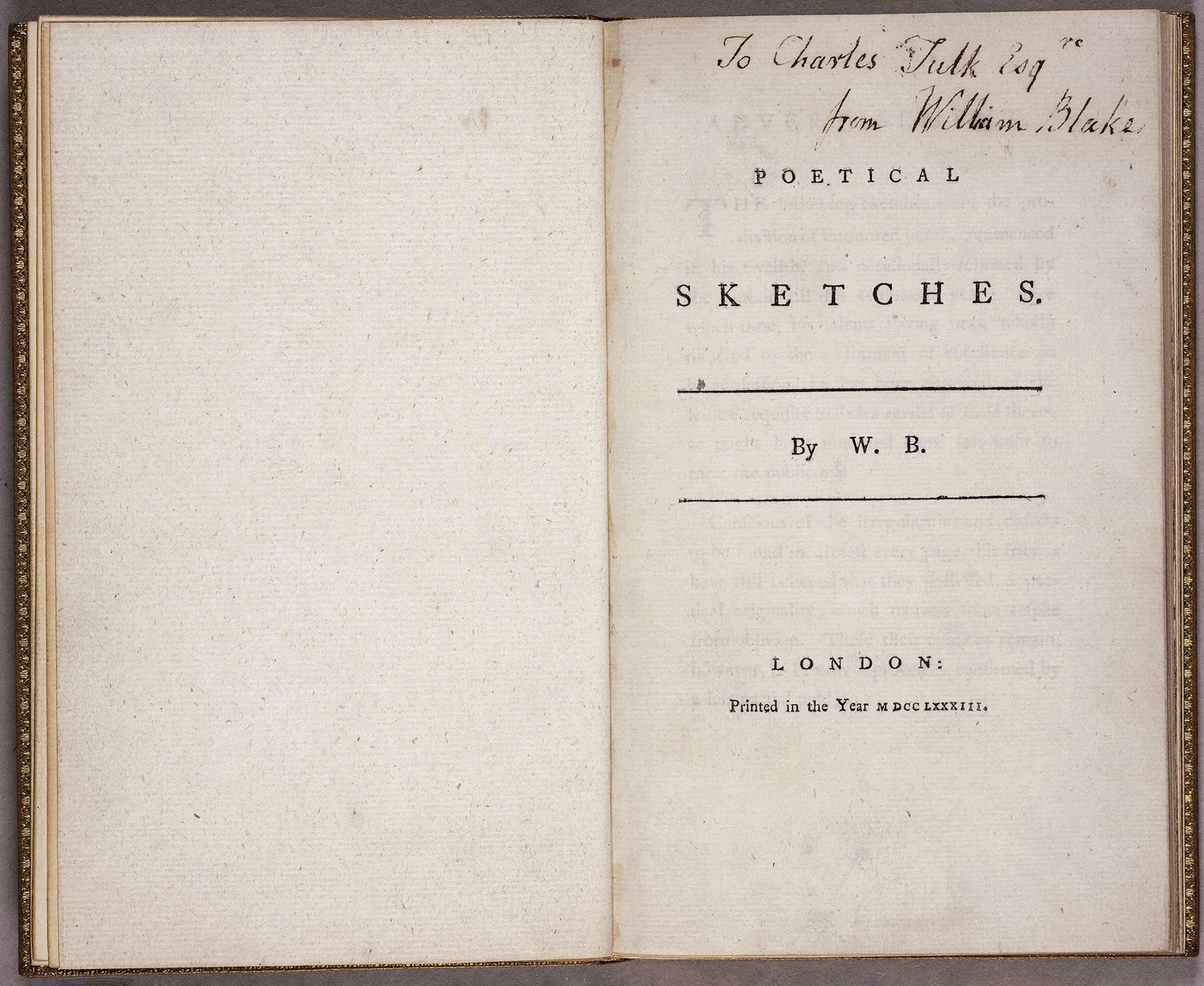The William Blake Archive is pleased to announce the publication of a digital edition of Poetical Sketches, composed by Blake between c. 1769 and 1777.
Blake’s experiences in the London social circle of the Rev. A. S. Mathew and his wife Harriet in the 1780s gave him both inspiration and opportunities. An Island in the Moon, a manuscript fragment that includes poems and songs in wacky satirical contexts, is an early vehicle for his impressions of the Mathew circle. Poetical Sketches is a more serious, in some respects major, literary experiment that grew out of the accumulated earlier efforts of this multi-talented engraver’s apprentice to write poems and poetic prose sketches some of which he later probably recited and sang in company. The Mathews must have been impressed, because they joined with the artist and sculptor John Flaxman to subsidize the printing, in 1783, of Blake’s first and only typographical collection of poetry. (For what is known about the printing, see the note under Publisher on the Copy Information page.) It was a rudimentary printing job rather than a formally published volume: perhaps fifty copies of eleven sheets that could be folded and assembled into small volumes with a title page presenting “W. B.” as author followed by a one page, unsigned “Advertisement” for these displays of “poetic originality, which merited some respite from oblivion” (Object 2). The uncorrected sheets were apparently left in Blake’s hands to do with as he saw fit, which, surprisingly, was nothing more than to present individual volumes to friends and patrons now and then throughout his life. He (and others) variously corrected and emended some copies but left others untouched. Only about half—at the latest count twenty-four—survive.
Despite its somewhat unpromising origins, Poetical Sketches remains vitally important in its revelations of Blake’s reading habits and early accomplishments—several fine poems, including the often anthologized “I Lov’d the Jocund Dance” and “How Sweet I Roam’d from Field to Field”—along with strong anticipations of his developing styles and interests. The collection materializes at a productive literary intersection of Elizabethan and neoclassical poetics, biblical allusion, late eighteenth-century innovations, emergent Romantic modes, and idiosyncratic mythopoeic genius. A Shakespearean invocation to the muse begins “King Edward the Third,” while it, along with “Edward IV” and “King John,” sets a tone similar to Shakespeare’s history plays. The stimulus of popular eighteenth-century poems—James Thomson’s The Seasons (finished in 1730), Edward Young’s Night Thoughts, and James Macpherson’s pseudo-medieval Ossian poems—can be felt. And, of course, Blake’s key predecessor John Milton leaves his mark, particularly in “Contemplation” and “Samson.”
Although the earliest works may have been drafted when Blake was an “untutored youth” (Advertisement, Object 2), the collection conveys a powerful sense of the original author he was fast becoming. His visionary or prophetic mode (“Gwin, King of Norway”), his underlying social and political commitments (in the ironic “King Edward the Third”), and his easy assimilation of new literary trends (the gothic “Fair Elinor”) are all evident. As miscellaneous as it is, Poetical Sketches anticipates the major literary work soon to come.
As always, the William Blake Archive is a free site, imposing no access restrictions and charging no subscription fees. The site is made possible by the University of North Carolina at Chapel Hill with the University of Rochester, the continuing support of the Library of Congress, and the cooperation of the international array of libraries and museums that have generously given us permission to reproduce works from their collections in the Archive.
Morris Eaves, Robert N. Essick, and Joseph Viscomi, editors
Joseph Fletcher, managing editor, Michael Fox, assistant editor
The William Blake Archive

